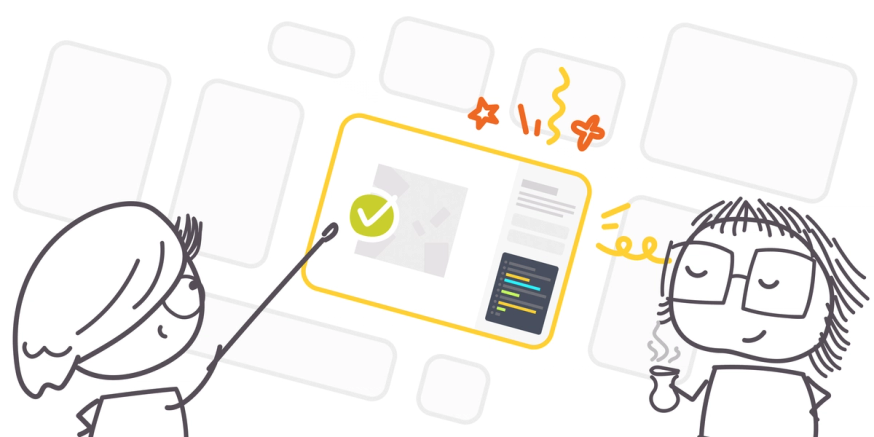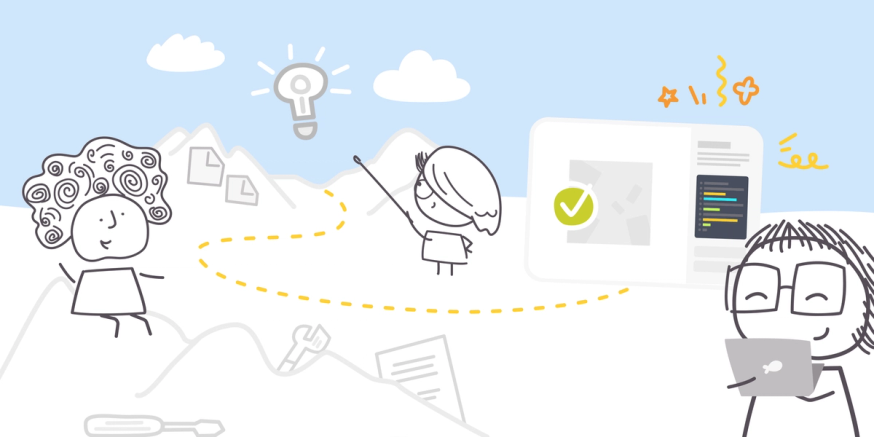Think of any digital experience or product you’ve enjoyed in your everyday life, like scrolling Instagram or TikTok for hours on end, reading Reddit on the toilet, looking up travel destinations on Google, or ordering groceries through Amazon or Instacart. The list goes on and on. Each of these digital products have countless features that are thoughtfully designed and highly performant — but that wasn’t always the case.
Every part of those products, down to the corner radius of a button, started out as a concept. From there, each concept journeyed through a design process that resulted in what you see and experience today.
In this article, we’ll talk about what the design process looks like and why it’s important for design teams to create a process that nurtures the best of their creative ideas from concept to final design.
The design process (and why it is important)
Achieving good design takes more than simply time and talent. It takes clarity around a specific goal, and when a larger team is involved, collaboration and alignment. For that reason, the design process is crucial because it’s the disciplined approach that guides creative teams towards a clear and meaningful goal for their design work.
The design process is very important to non-designers, too. For example, when you’re designing a digital product, cross-functional team members such as product managers, researchers, analysts, developers, and other stakeholders have valuable input for what is being designed. The design process makes it easier for those different individuals to get involved at the right time, such as during market research, brainstorming, user testing, and Design Delivery.
Ultimately, the design process provides healthy guidelines to ensure that your design concepts meet user needs while staying brand consistent.
What does the design process look like?
No two creatives have the same exact process and that’s also true for design teams and their design processes. Teams and individual designers who are focused on UI design will have a different approach than those who are doing graphic design or interaction design.
That said, there is a common set of steps that most teams follow when taking on any substantial design project.
Design process steps
The five main steps in the design process are Empathize, Define, Ideate, Deliver, and Test. You might hear different names to describe these steps, but this is how most design processes unfold. And as for what happens within each step, it depends on what you’re designing, your team setup, and other constraints in your organization such as budget, industry, and more.

Step 1: Empathize
The first step in the design process, also referred to as “Discovery”, involves the same initial effort required for any new business challenge: identifying and empathizing with your target user and their needs. This effort to deeply understand your users includes activities like market research, UX research, conducting user interviews, and finally, bringing together all of the information you’ve discovered so that it contributes to and improves your design thinking.
This step takes longer when you’re designing a brand new product or if your design project is complex, like an application, website, or comprehensive digital experience, because the amount of user research you’d need to fully empathize with your end user is greater.
Step 2: Define
What have you learned about your user? What problems are they running into? How are they currently dealing with them? What could you create to make their life better?
These are some questions to answer at the second step of the design process, which is all about defining your problems, goals and boundaries. Here, you’d take what you’ve learned about your users' needs and narrow down what matters. For some teams, this step might include creating user flows and personas, drafting design briefs, and holding meetings to gain alignment on design scope, deliverables, responsibilities, and timelines.
Step 3: Ideate
The third step of the design process is what most people envision when they think of a designer’s creative process. Often messy to some degree, the ideate stage is where designers brainstorm ideas, challenge assumptions, and ultimately create a solution to a problem they’ve defined in earlier steps. Typically, the outcome of this step is some sort of design work product, such as wireframes, mockups, or first drafts.
Step 4: Deliver
The deliver step of the design process is the turning point when designs begin to feel real because they are shared with others in the form of a prototype or MVP. When building digital products, this is where the the principles of design delivery comes into play because this determines how efficiently developers can transform the design vision into a final outcome that solves users’ needs.
In this step, you’ll often find design presentations, design handoff meetings, and depending on your design tool of choice, Figma, Sketch, XD and Photoshop.
Today, Zeplin is the world's leading design delivery platform, ensuring your design vision carries through your design process all the way to the final product. Hear from our CEO on how Zeplin solves design delivery, dev handoff, and more.
Step 5: Test
When designing digital products and experiences today, you’ll rarely find a designer designing something and never touching it again. That’s because the most successful designs are a result of an iterative approach, where there’s a continuous cycle of updates and improvements to the design based on feedback from users and customers. After a design has been user tested, it may go back to the ideate stage to get further refined.
The importance of the design process
The design process provides structure to what might otherwise be lots of creative ideas that have nowhere to go. Establishing a design process improves team collaboration, increases the quality and speed of your design work, and makes it more likely that everyone – especially your end users – is happy with your final designs.
Here are some specific positive benefits of a solid design process:
1. Set clearer expectations
While an individual designer’s creative process might be somewhat chaotic and messy, the design process as a whole is not. There’s a predictable sequence of activities that everyone in a larger organization can understand. As a result, timelines are more predictable and there’s less need to wonder “what’s happening with the design?”
2. Improve teamwork and alignment
You can have the most talented design team in the world, but it doesn’t matter if there isn’t clarity and a common workflow that gets everyone working in sync. Maintaining an organized design process leads to better teamwork and alignment by providing clarity on design scope and objectives, who is responsible for what, and which activities must happen in what order.
3. Create more efficiently
The design process is like a workflow template to follow, and we all know that templates help us all work faster. So with everyone on the same page, multidisciplinary team members know how and when they can contribute during the design process, which means you can make important design decisions more quickly along the way.
4. Deliver final designs that meet user and business needs
The design process forces you to consider your user and their needs from the very start, which reflects positively in your final design and user experience. And because the design process also gives space to proper delivery and testing, your team benefits from less friction during developer handoff and more certainty that the final designs meet all of the goals you intended for them.
5. Gain happy users
The ultimate goal for any design project is not just to solve a problem, but to also make users happy. The design process gives you that extra layer of assurance that you’re doing the right thing and creating something that your users will actually enjoy.
Common design process challenges
Whether you’re designing a small product feature, an entire website, or something in between, a few of the same challenges seem to always pop up in the design process.
Communicating design intent
Staying true to your vision and design intent from ideation all the way to finished product is a big challenge in the design process. That’s because it’s not easy to communicate lots of design information to multiple members of a product team who aren’t designers themselves.
Imagine having to describe a moving art installation to a room full of people, including what it looks like, how it moves, and the smallest of details. On top of that, each person in the room has varying levels of knowledge about art in general. This represents the communication challenge that happens during the design process between designers, product managers, developers, QA, stakeholders, and more.
Making designs that stand out
How do you ensure your new designs actually make an impact on your users and don’t get overlooked among competitors? And how do you push the envelope with your design concepts while also honoring your brand and user needs?
Making designs that stand out is a timeless challenge for design teams and it comes up often in the design process, as that’s when you have to make trade-offs between what’s exciting vs. what’s practical.
Sharing designs with developers
For design projects like applications, websites, and full digital products and features, never underestimate the importance of Design Delivery. It represents the “passing of the baton” between the designers and developers, two groups who operate from different sides of the brain yet rely on each other to realize a shared design vision.
While many think of this process as “design handoff”, relating to only specs, what developers actually want when receiving designs is clarity and efficiency for their development workflow. Things that contribute to this are design version control, clear instructions on design behavior, the big picture context of how designs fit in a user flow, and reusable design elements in a design system.

Get the handoff right with Zeplin
The design process is where design creativity meets business problem solving, and it gives your team the much needed structure for team collaboration and efficiency. Designer-developer collaboration is a critical part of this process when building digital products and experiences: for those teams, Zeplin maximizes their ability to work together to ship products with excellence and speed.
Try Zeplin for free and see how Zeplin makes all the difference in your design process and beyond.
Importance of design process FAQs
Why is the design process important?
The design process is important because it's the foundation that enables you to imagine and create better products and experiences for your end user. It brings your team together around a shared workflow where everyone has clarity on who you’re helping, what you’re trying to achieve, and what success looks like with your designs.
How many steps are in the design process?
The design process can vary depending on the size of the team, the product you're designing, and personal preferences, but in general there are five steps in the design process, which include Empathize, Define, Ideate, Deliver, and Test.
What is the most important step in the design process?
All the steps in the design process are important, but the one that is most underestimated is Delivery. Zeplin recently surveyed nearly 200 designers, developers, and product managers and found that the majority spend 4-8 hours per week explaining or interpreting design files. With a better Deliver process, teams have better alignment and ship better products faster.
How can the design process be improved
There’s no such thing as a perfect design process and different teams will have their own areas for improvement. But usually, the best ways to improve the design process is to clearly define and communicate your design scope and goals across your team, and to reduce the manual work and friction for designers and developers during design delivery.




